1948
The new brigade was to have its Headquarters at Leamington Spa, and was to consist of seven full-time stations and fifteen retained part-time stations. The county was divided into two sections, north and south, with 160 full-time staff. In the southern section, there would be full-time stations at Stratford upon Avon, Leamington Spa and Solihull, and retained stations at Alcester, Bidford, Fenny Compton, Kineton, Kenilworth, Tysoe, Shipston on Stour, Southam, Studley and Warwick.
It was anticipated that in the south of the county the full time staff would total 122, with a further 220 part-time staff. Tysoe Station became No. 27 with Leading Fireman F Heritage in charge. The remaining members of the crew were retained firemen with the sole exception of Fireman W J Jackson, who remained the only volunteer from 17 June 1948 until 6 April 1957.
The appliance was an Austin Towing Vehicle and a Dennis Major Pump capable of delivering 350 gallons per minute.
The siren was tested every Wednesday at 0900, and the bells in the Firemen’s homes were tested every morning at 0800.
There was little excitement at the station during the year, as the only recorded call was to a paraffin container on fire at Kirklands Farm, Tysoe. The container was extinguished with fire extinguishers and a hose reel.
There was a serious fire at the Central Ammunition Depot at Kineton within the first year of the Warwick County Fire Brigade, when seven stations were called to a fire of some 900 tons of smoke ammunition. C.A.D. Kineton has a boundary near the edge of Tysoe parish, approximately 1 mile only from the Tysoe Station, but the Tysoe crew was not called to the fire.
1949
There were three fire calls during the year, the first of which, on 4 August, was at Garrett’s Farm House, Lower Tysoe (now Brown Beams) where the thatched roof was burning. Ten fire brigades attended the blaze, from Tysoe, Shipston on Stour, Stratford upon Avon, Banbury, Leamington Spa, Warwick, Moreton-in-Marsh, Chipping Norton, Chipping Campden and Stow on the Wold. They fought the fire for 3 hours in an eventually successful effort to save two thirds of a 40-yard long row of stone and thatched cottages. The efforts of the teams fighting the fire were seriously hampered by the absence of any available mains water supply in the village or, indeed, of any open water supply other than the garden well. Six Water Tenders ran a shuttle service to the lake at Compton Wynyates, an eight mile round trip back to the blazing building. Villagers formed a chain to carry out the furniture. It was thought that smoke and sparks from the kitchen cooker may have caused the fire. Three jets were used to control the fire.
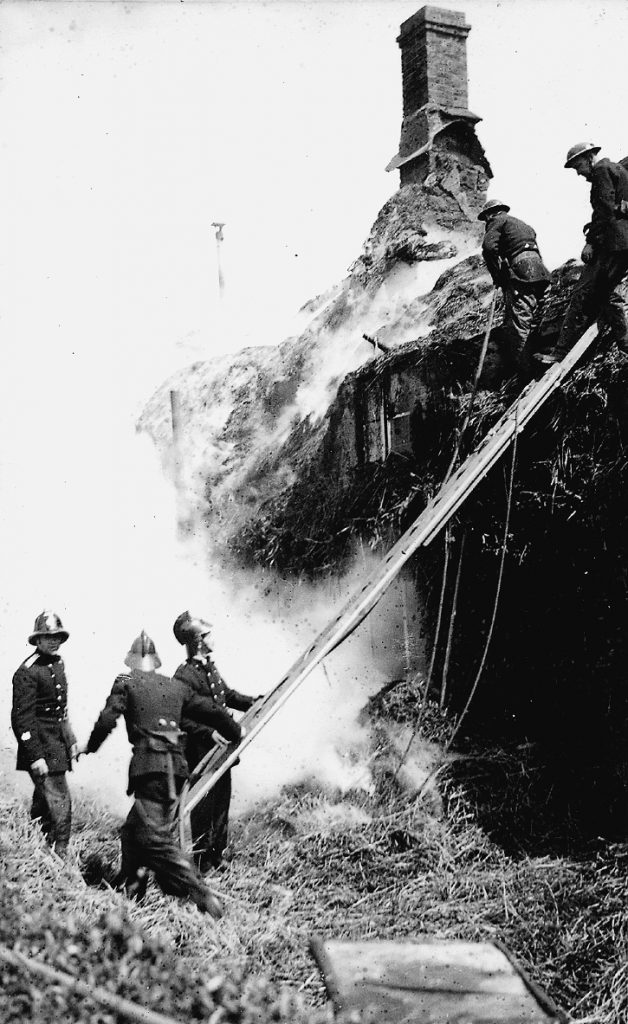
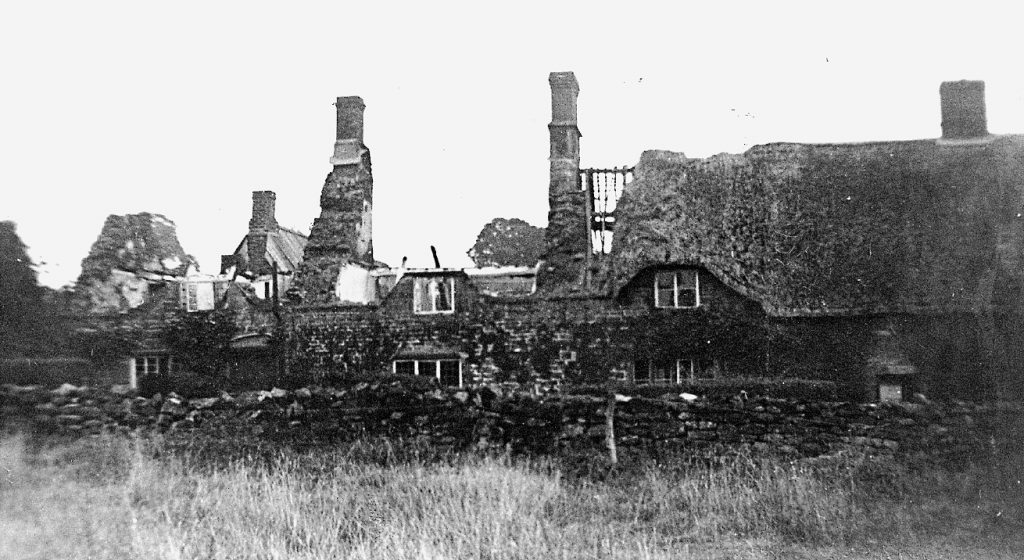
On 26 August, the crew was called to a fire in a two-storey barn at Lower Brailes using three jets and a hose reel jet to bring the fire under control.
On 6 November two ricks were on fire at Shipston on Stour. One again, three jets were used.
1950
There were three calls during this period also. The first, on April 5th, was to C.A.D. Kineton to what turned out to be a malicious false alarm in the high risk ammunition area.
The second fire of the year was on 10 May, and was to the Downs’ Farm, Tysoe, to deal with a tractor that was on fire. Hand extinguishers were used with success.
On 9 August it was back to Downs’ Farm again, this time to a fire in a barn and stable. Two jets were used to put this one out.
1951
Only two calls were recorded during the year.
On 5 February, a fire in a private house in Stourton resulted in two-thirds of the house and the whole of the roof being destroyed. 3 jets were used on this occasion.
On July 20 the crew was called to Campden Road, Shipston on Stour, to a Special Service Call. This is a call which does not involve a fire. A trench had collapsed on top of a workman laying new pipes. It was said at the time that the man came across some old bones and, as he threw them out of the trench, it collapsed. The bones were said to have belonged to an old witch. The workman died from asphyxiation.
The turn-out pay for this year was Sub Officer £0-16-0d, Leading Fireman £0-12-0d and Fireman £0-10-0d. The attendance fee was £0-5-0d and the hourly rate £0-3-0d.
The crew and pump went to the fire station at Solihull during May for the Brigade Review.
1952
Two serious fires took place during the year.
On 27 April, fire engulfed a row of five thatched cottages at Workers Row, Lower Brailes. The fire had started when blazing fat in a frying pan set fire to a chimney and in no time the thatched roof was ablaze. In all, seven Fire Stations were called, from Shipston on Stour, Tysoe, Stratford upon Avon, Kineton, Fenny Compton, Leamington Spa and Bidford on Avon.
The call was at 10.47am and water was obtained from a stream some three-quarters of a mile away, by which time the fire had taken a good hold in the strong breeze. Almost all of the furniture and personal effects were saved, thanks to the efforts of the firemen and help from most able-bodied men in the village.
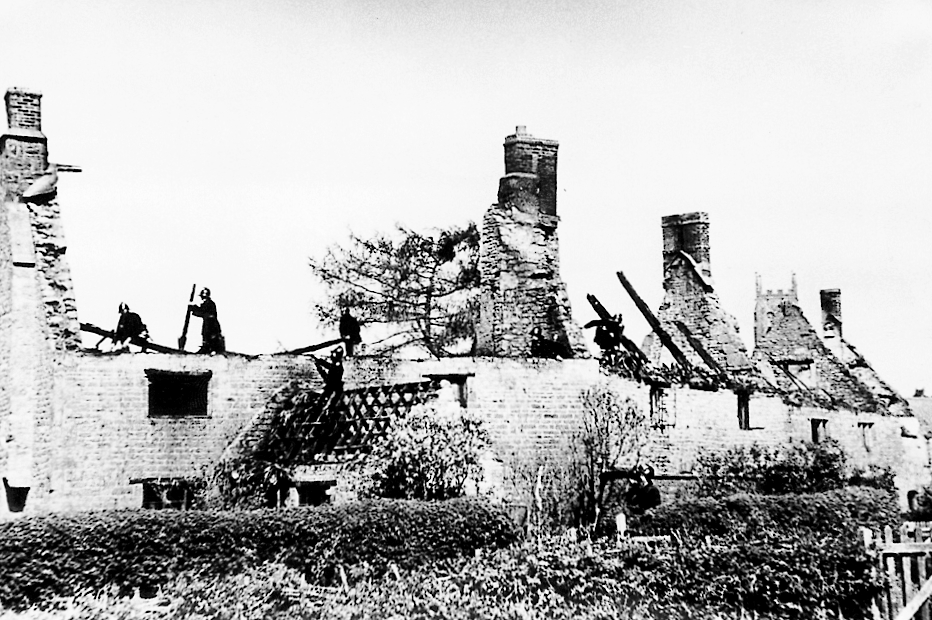
On Saturday, 27 September the Tysoe crew received a call at 06.00 to attend a fire in a three bay Dutch Barn at Marsh Farm, Stourton. Six jets were required and the crew left at 14.30 on the Saturday and returned the following day, working from 08.30 until 16.30. This was jocularly referred to as the Station’s Annual Outing.
Since there was still no mains water supply in Tysoe, a 5000 gallon tank was installed in the yard of Mr Boycott, the village butcher, opposite the thatched Fire Station. This supply was to be used for firefighting only.
The Austin Towing Vehicle, which had been used since 1948, was replaced by a Hose Reel Tender, which carried 100 gallons of water and had a separate pumping unit working from the engine via the power take off drive.
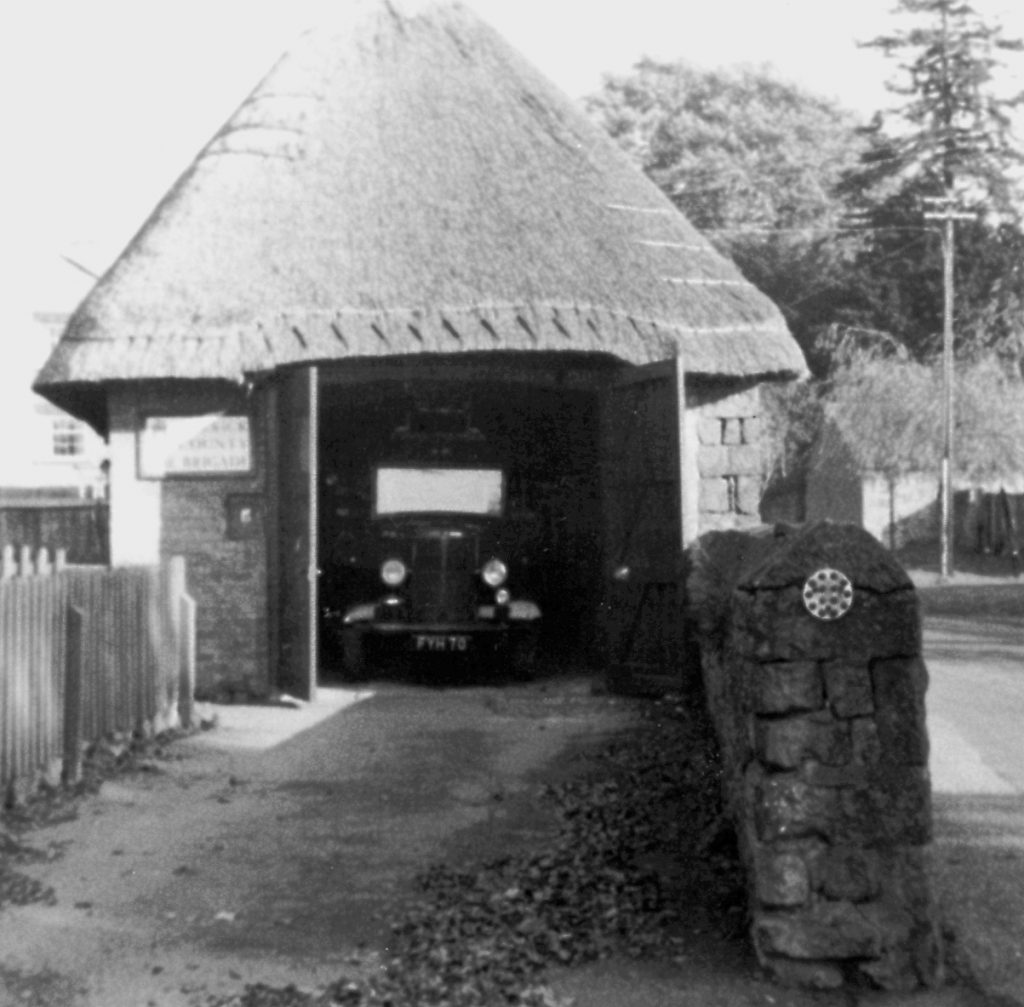
The station had a test turn-out during February and set a record time for retained stations, by having the Fire Engine mobile with four men on board in just 39.5 seconds. In fact, seven men were in attendance.
1953
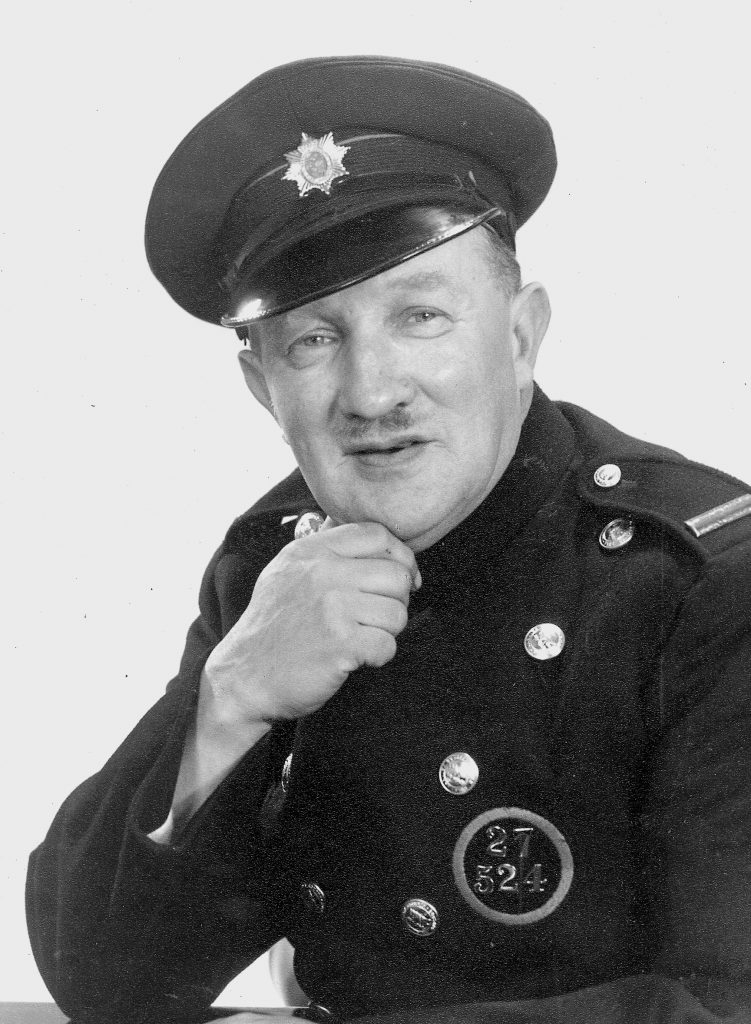
Only two calls were recorded during the year, one of which was a chimney fire at Tysoe Hill Cottages on 16 January, at which one hose reel only was used, and the other to a lorry which was on fire on the Oxford Road at Burmington, near Shipston on Stour. Two jets were used to extinguish this fire.
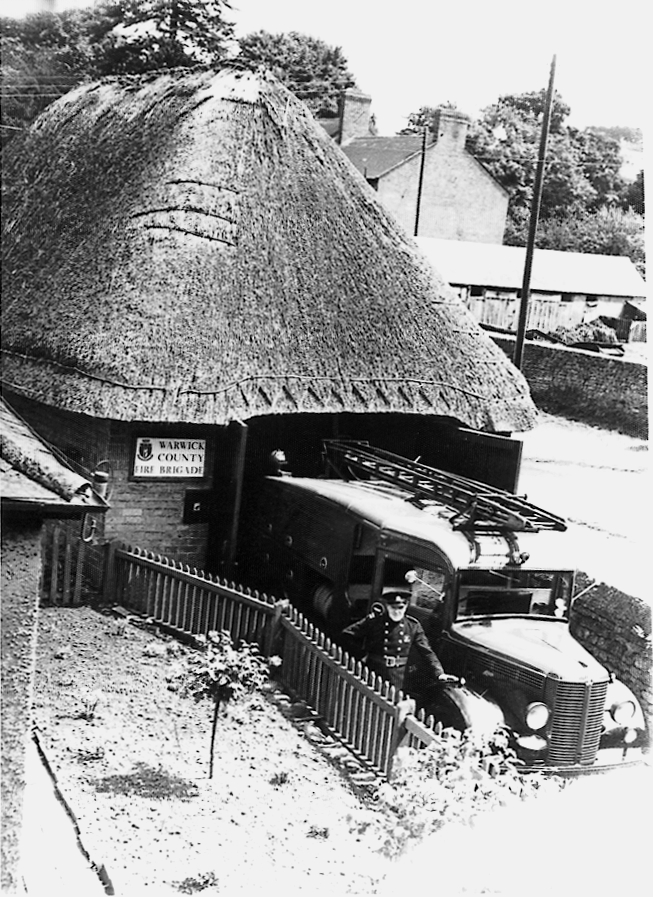
Leading Fireman F Heritage was promoted to Sub Officer and Fireman B King to Leading Fireman.
There was an accident on 9 September 1953 on Sunrising Hill, as a result of which a crew from Kineton was called to free three people who were trapped in vehicles, but the Tysoe crew was not called.
1954
No calls were received during the year. This appears to have been a year dedicated to fire drills, and Tysoe must have been home to one of the more highly trained crews of the time.
1955
Leading Fireman B King retired from the Brigade after 33 years of service. He was presented with a clock by Sub Officer Heritage, who spoke highly of Mr King’s abilities and practical knowledge.
Five calls were responded to during the year.
On 16 March the crew was called to Stamford Hill Farm, Pillerton Priors, where eight ricks were on fire. Hose reels were used for damping down purposes.
The Tysoe crew was called on 8 August to a smaller fire at Campden Road, Shipston on Stour, where one rick was alight, but no assistance was possible due to the lack of an available water source.
A fire on 23 October at Quinis Cottage, Aldermister, was successfully extinguished, and three jets were used to deal with another fire in a Dutch barn on Spencers’ Farm, Burmington, on 27 October in the same year.
This proved to be a busy few months, since just a few weeks later, on 16 November, the crew attended a blaze in a wooden building at Mayo’s Timber Yard, Shipston on Stour. Here again, this was extinguished on arrival.
The Station won a record for the best turn-out time for a part-time station in Warwickshire in a time of only 30.5 seconds with 4 men on Board.
1956
Just four calls were recorded during the year.
On 27 January the crew attended a house fire at Uplands Farm, Edgehill, where services were not required, and on 4 March a fire in a poultry shed at Chelmscote Farm, Brailes (again services were not required). On 23 July a hose reel was used on a burning rubbish tip at Dry Hill Hollow, Upton Estate, Edgehill, and on 8 December, ‘with good intent’, they responded to a false alarm at Oxhill.
New water mains were at last being laid in the village and the hydrants being installed in the village streets were now of great assistance to the fire-fighters. Prior to this the only sources of water for fighting fires were the streams and village ponds. The old water supply to the village had been provided in 1885.
The firemen’s pay for the year was as follows:
Retaining Fees for Station Officer £80-0-0d, for Sub Officer in charge of Station £65-0-0d, for Sub Officer £52-0-0d, for Leading Fireman £44-0-0d, for Fireman £40-0-0d, and for a Female Member £30-0-0d.
Turn-out Fees for Station Officer £1-1-0d, for Sub Officer in charge of Station £0-19-0d, for Sub Officer £0-19-0d, for Leading Fireman £0-17-0d, for Fireman £0-15-0d, and for Female Member £Nil.
Attendance Fees for Station Officer £0-11-0d, for Sub Officer in charge of Station £0-10-0d, for Sub Officer £0-10-0d, for Leading Fireman £0-9-0d, for Fireman £0-8-0d, and for Female Member £0-6-0d.
The Hourly Rate for Station Officer and Sub Officer was £0-7-0d, for Leading Fireman and Fireman £0-6-0d and for Female Member £0-3-0d.
1957
Fireman J H Quinton was promoted to Leading Fireman.
Fire calls were up to eight in the year, comprising the following:
On 19 February, a chimney fire was reported at Whatcote.
On 17 March, a room fire at Rectory Farm, Whatcote was extinguished.
On 28 May, a hose reel was used to deal with a fire in the wooden cricket pavilion at Kineton.
On 22 June, a hose reel was again used, this time to put out a chimney fire in Kineton.
On 2 August, a fire in a corn drier at Paynes Farm, Whichford, was reported, but services were not required.
On 23 August, a lorry fire was reported in Oxford Rd, Shipston on Stour, but services were not required.
On 9 September, there was a chimney fire at Tysoe Manor, where three ladders and a hose reel were used. More than one thousand gallons of water were hosed down the chimney and it is reported that ‘not a drop came out of the fire-place’. Instead it all went up as steam.
On 29 November the crew went to Green Lane, Shipston on Stour to a fire in some hay ricks, where two water jets were used.
1958
Six calls were recorded during the year.
On 16 February one hose reel was used to control a chimney fire in Cherington.
A call was received on 20 March in respect of a boiler explosion in Cherington at Cherington House, but services were not required.
On 5 April a tractor caught fire at Kings Brake Farm, Long Compton. The fire was extinguished on arrival, and one hose reel was used on 13 April at a chimney fire at Lower Tysoe.
The Fire Station building was owned at this time by Sub Officer F Heritage.
The use of a hydrant and one jet was necessary on 13 July at a Dutch barn on Meads Farm, Butlers Marston.
On 6 October two jets were required to contain a fire in a Dutch barn full of baled hay at Manor Farm, Willington.
1959
Activity was increased during the year, no fewer than fifteen calls having been recorded.
On 6 January the crew attended a lorry fire on the Oxford Rd, Shipston on Stour.
Four chimney fires were attended during April and May, at Brailes Bakery,Kineton, Shipston on Stour and Tysoe, with one hose reel used at each fire.
The crew’s services were not required on 23 June in a shop in Shipston on Stour at a fire, which was extinguished by Shipston on Stour Fire Brigade.
The use of a hose reel was required during July on fires in a store shed in Shipston on Stour and in a tree in Tysoe.
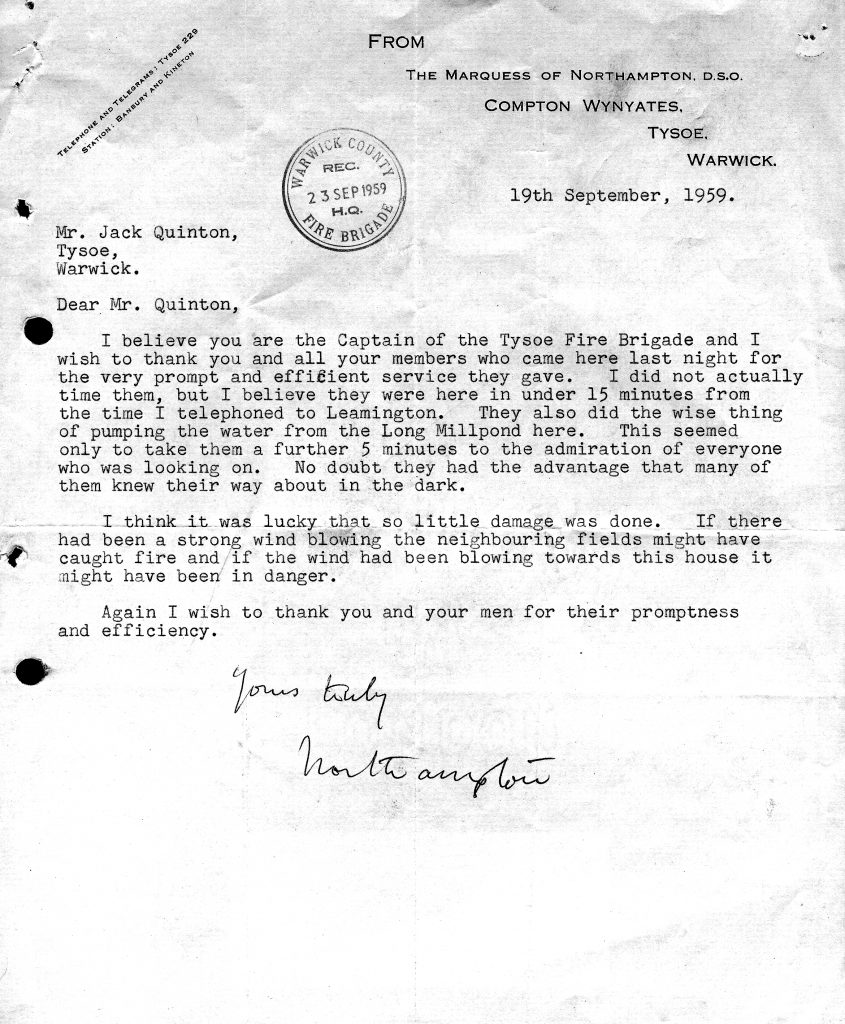
In September the crew was called to a fire in straw bales at Lower Brailes, where two jets were used with base pump from a hydrant, and to a fire in a basement at Norton School, Little Kineton, where a hose reel was used.
On 18 September a call was recorded to the woodyard at Compton Wynyates, where the timber store and garages were on fire. The call was at 23.15 and the crews spent most of that night and the following day at this fire. Two jets were used, drawing water from the mill pond lake.
A fire in grass and scrub at North Farm, Sutton under Brailes, was attended on 20 September, where beaters were used, and there were two calls during October, to a wood store at Farnborough and to a grass fire at Compton Verney. On each occasion, a hose reel was used.
The final call for the year was on 1 December to a boiler house fire at Shipston on Stour, where one hose reel and a foam extinguisher were used.
The Hose Reel Tender was replaced with a brand new appliance, which was of a special design with the ladder let into the roof of the cab and the bells removed from the roof and located on the front of the engine. This enabled the new Pump, which was a Karrier Carmichael Reg. PWD 120, to fit below the beams of the thatched roof of the Station.
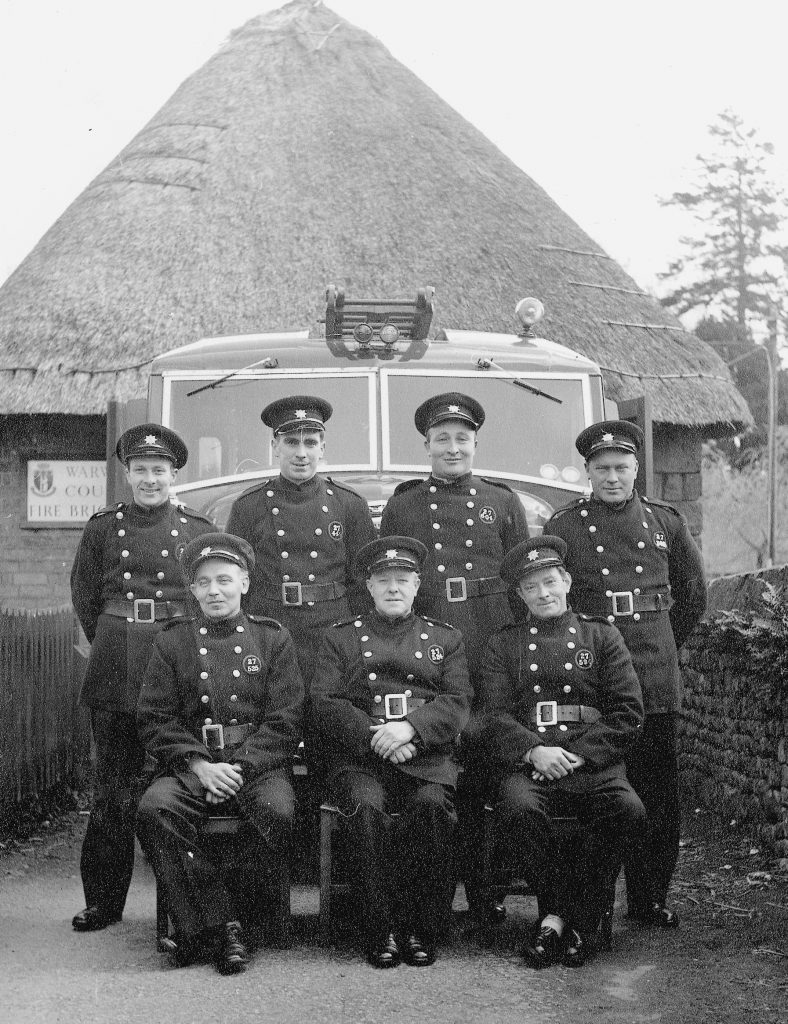
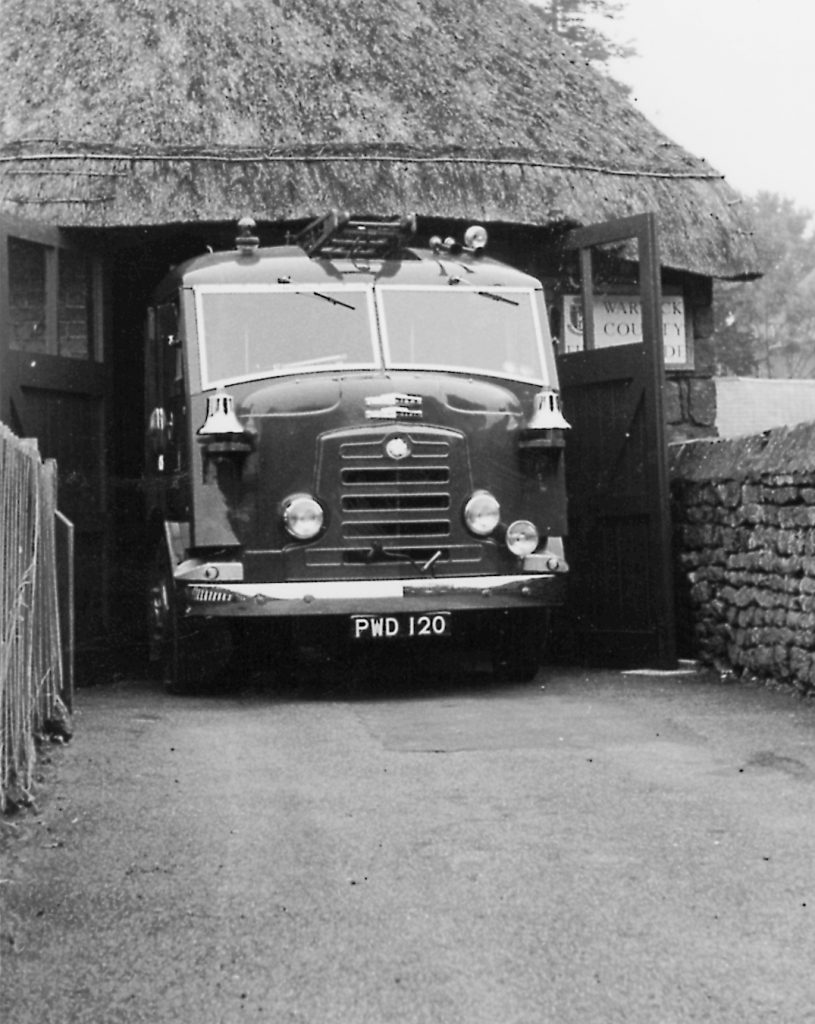
Sub Officer F Heritage retired in June and was presented with a briefcase by the Brigade.
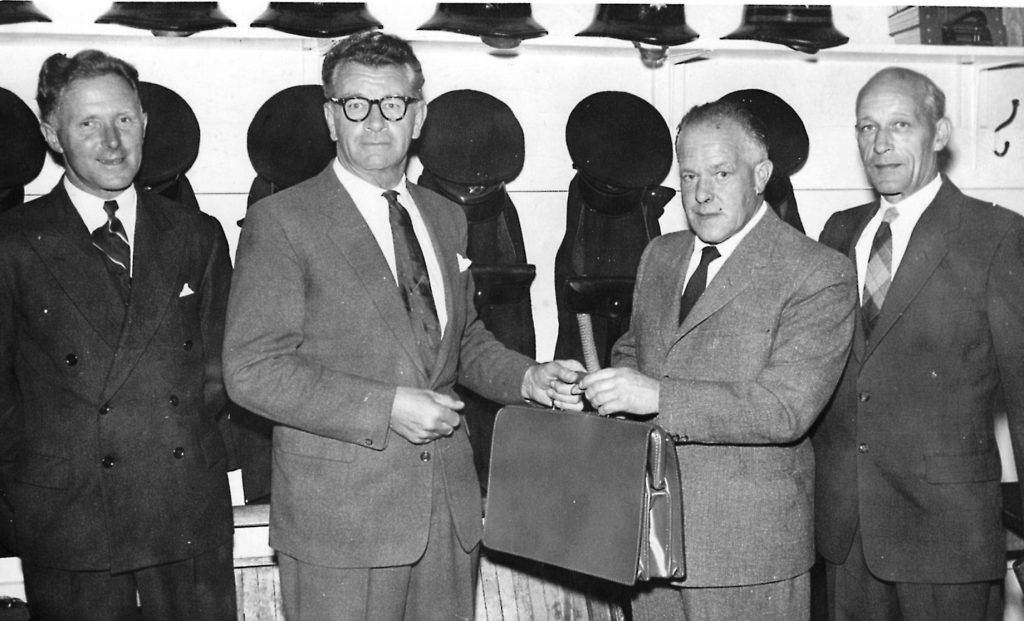
Leading Fireman J Quinton was promoted to Sub Officer during September.
1960
Fireman B Tarver was promoted to Leading Fireman in April.
The number of calls was reduced to eight during the year, which included a chimney fire, house fires at Honington and Butlers Marston, a special service at Chadshunt, two wood store fires, an electrical fire in the cinema at Shipston on Stour where one C.T.C. (Carbon Tetrachloride) Extinguisher was used, and a controlled burning on a farm.
At the end of May the Brigade Review took place on the riverside at Stratford upon Avon. A tower was constructed from scaffolding and covered in salvage sheet, and drills were conducted around the field and on the tower.
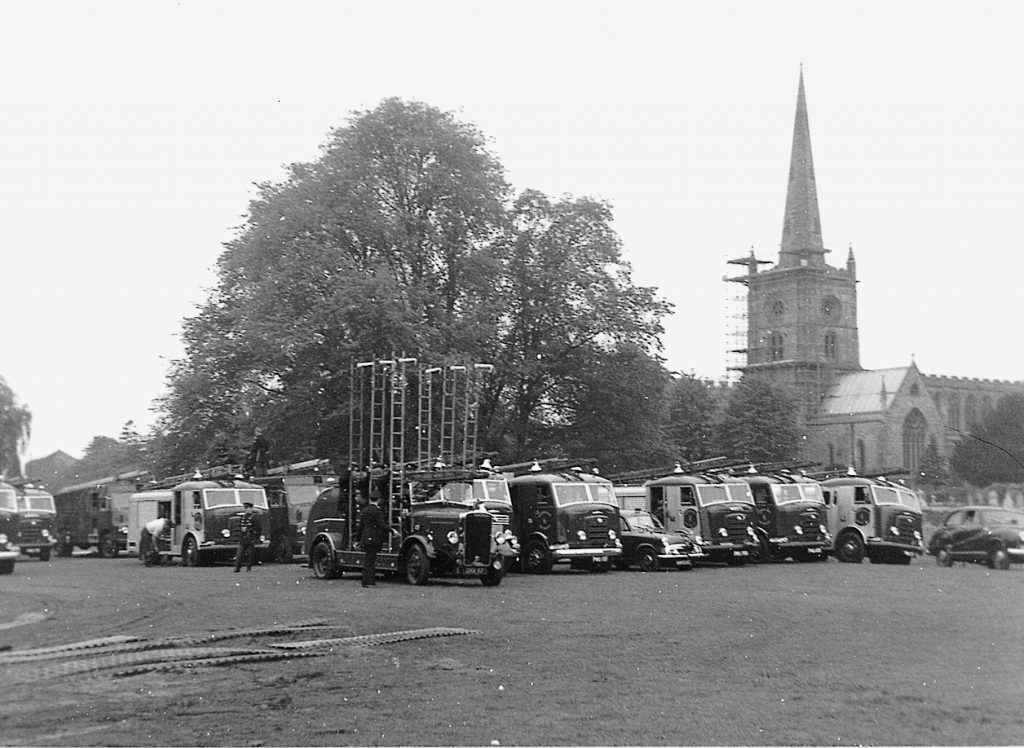
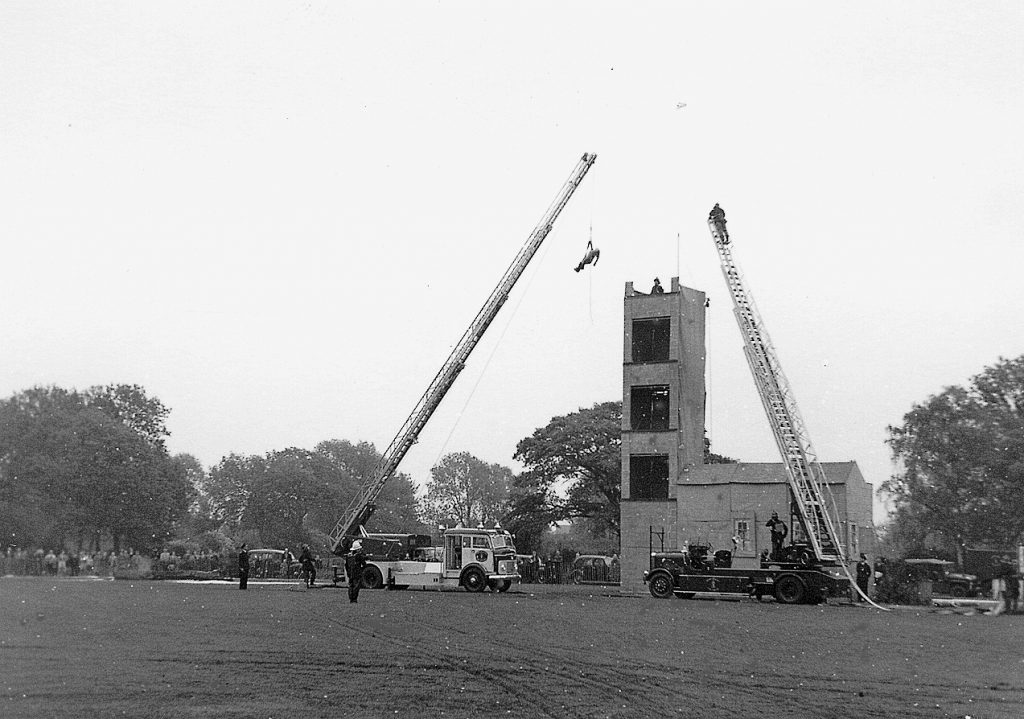
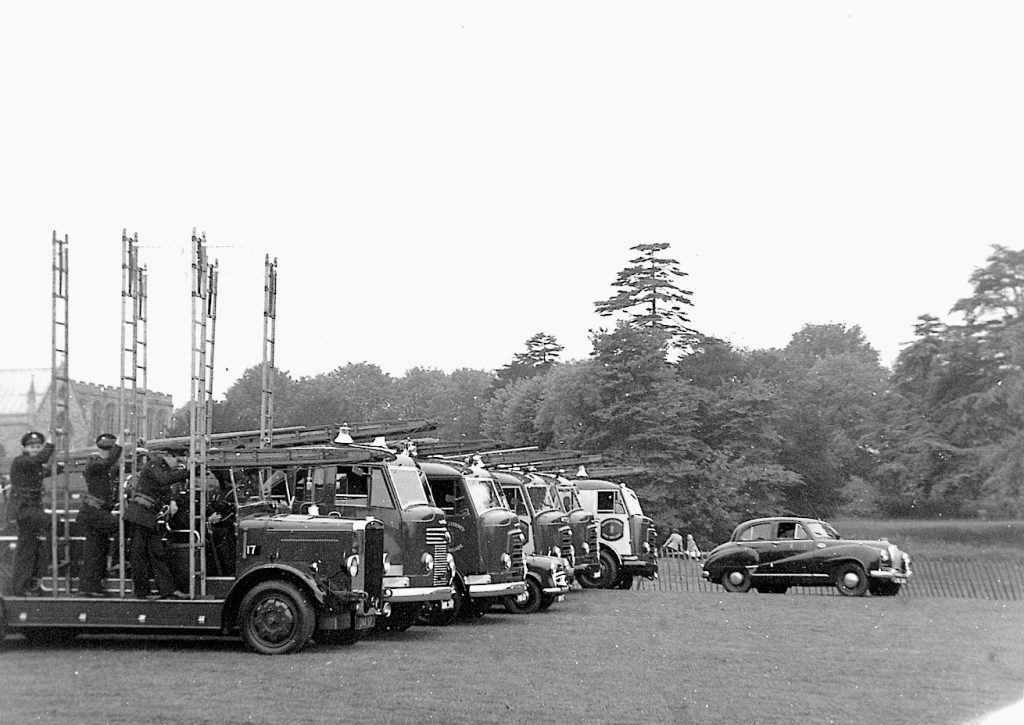
1961
A total of seventeen calls were recorded, which included two chimney fires, a fire at Pump House at Idlicote, a stove on fire at C.A.D. Kineton, three Dutch barn fires, at Shipston on Stour, Chesterton and Mickleton (open water hydrants with jets in use), two ricks on fire at Blackwell and at St Dennis, a barn and piggery at C.A.D. Kineton (two jets with a relay from open water), a fire on the railway embankment at Kineton, a combine harvester fire at St Dennis, two fires on open ground, and a fire in a thatched roof at Wroxton St Mary.
The Tysoe crew was successful in winning the Warwickshire hose running competition, which was held at Stratford upon Avon.
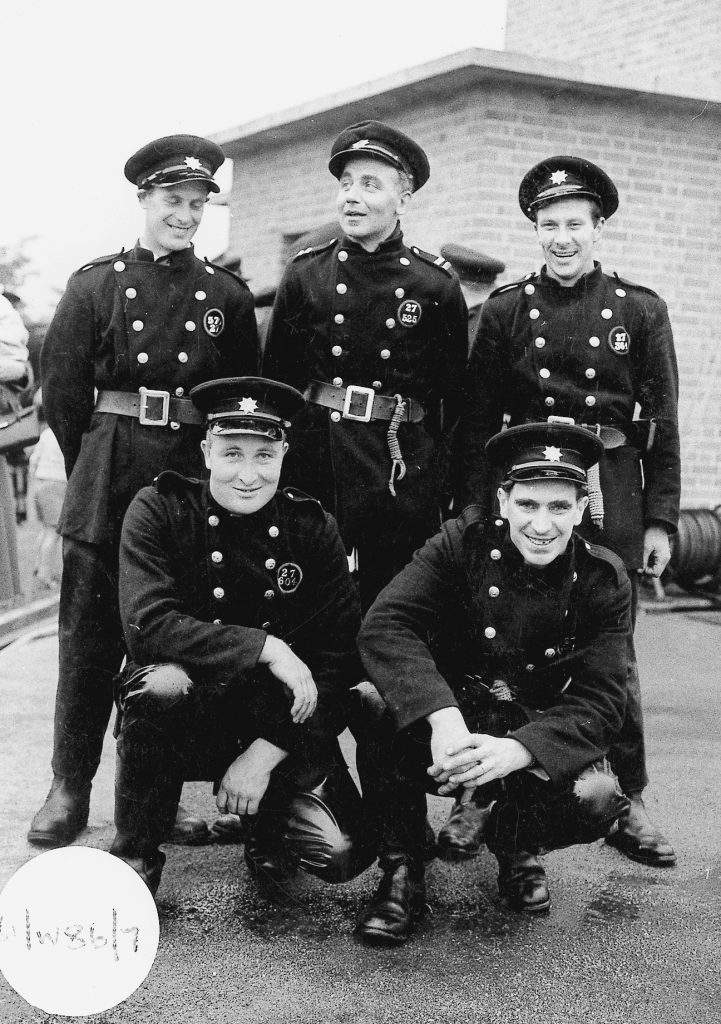
1962
There were still exercises with the A.F.S., with up to seventy pumps on occasion ending up at Blenheim Palace, Woodstock or at the Fire Service College at Moreton in Marsh. Some of these exercises were conducted in Wales.
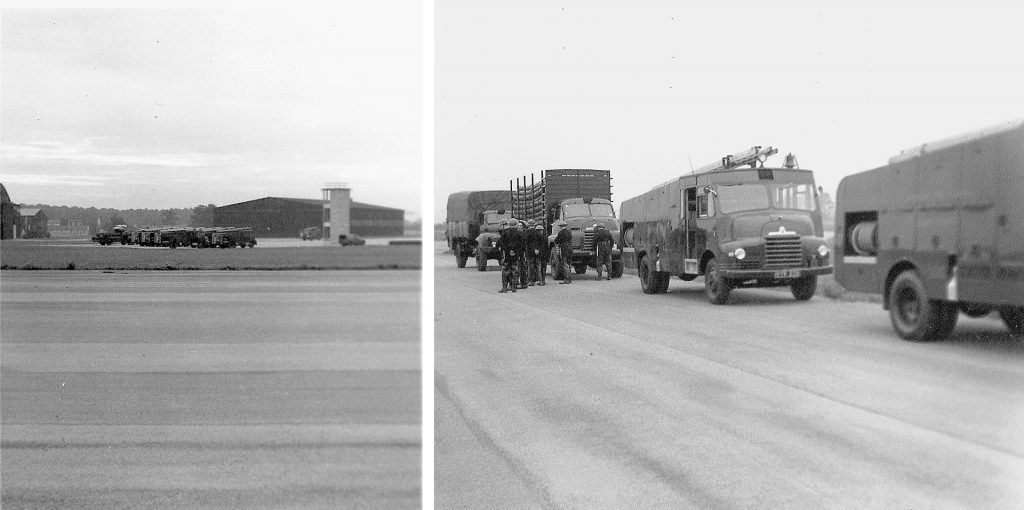
There were also the ‘Hot Fire Exercises’ on the R.A.F airfield at Gaydon, which was the operational base for the V bomber Force. Britain’s nuclear defence capability at the time rested with the Valiant, Victor and Vulcan bombers. The crews on these exercises were all required to sign the Official Secrets Act, as the aircraft were still on the secret list. On 2 October a Victor bomber crashed into woods two miles away from the airfield at the village of Combrook. The Captain remained at the controls and was killed, and the other members of the crew ejected at low level, two of them suffering fatal injuries.
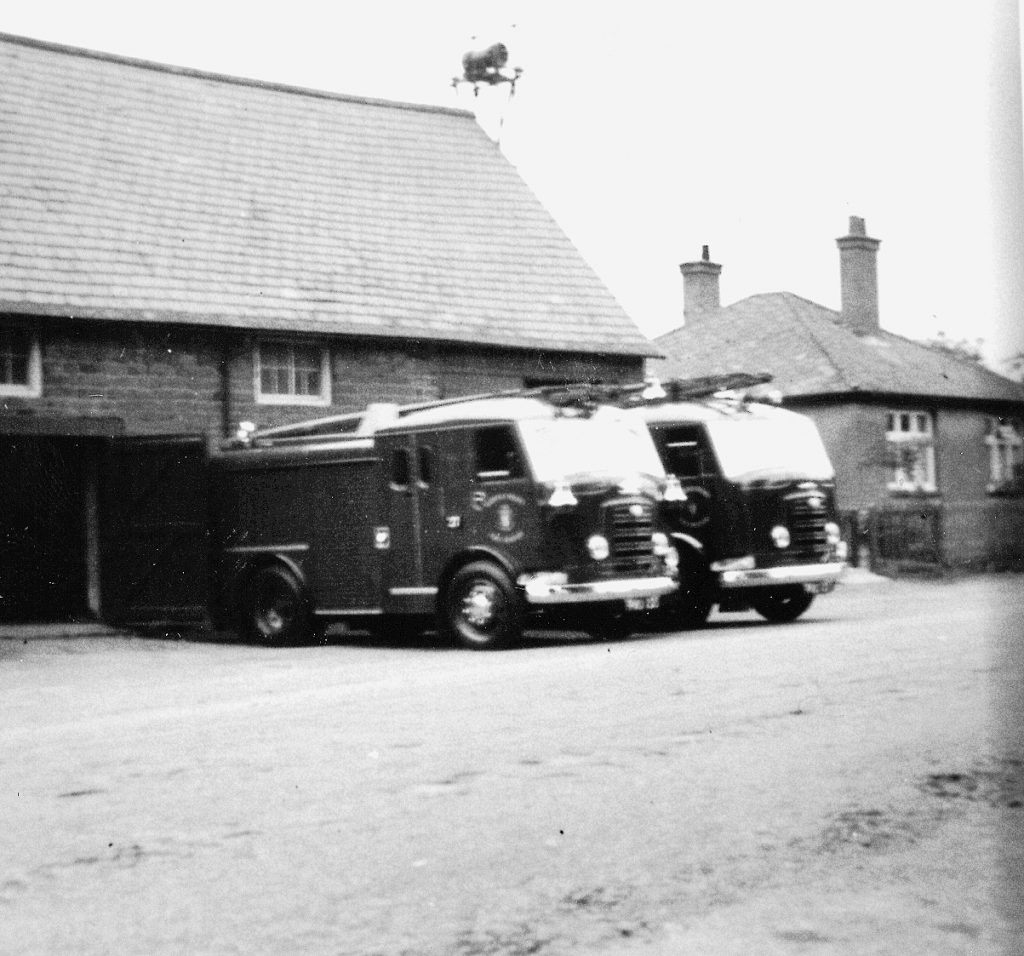
In the event of a breakdown on the Karrier Pump, a spare vehicle would be sent out from Headquarters. This spare pump would be of a standard design with the ladder on top of the roof, which of course meant that it would not fit under the beams in the Station. On such occasions the vehicle was ‘garaged’ in a barn next to the bungalow alongside the Station. The barn belonged to Mr and Mrs S Gardner, relatives of ex Sub Officer F Heritage, and the warning siren was located on a scaffolding tower on the end of this same barn.
Fire calls during the year were up to twenty-three, with nine chimney fires, one false alarm, four fires in burning straw or wood, two in vehicles, six house fires, and one fire in a thatched row of stables, for which a relay was run from the hydrant some three-quarters of a mile away.
The appliance was equipped with a radio, which had been used for the first time during a chimney fire at 6 Mallets Close, Tysoe, on 17 February 1962. Prior to this, it was customary for each appliance to carry four pennies, to be used when necessary in the nearest public phone box.
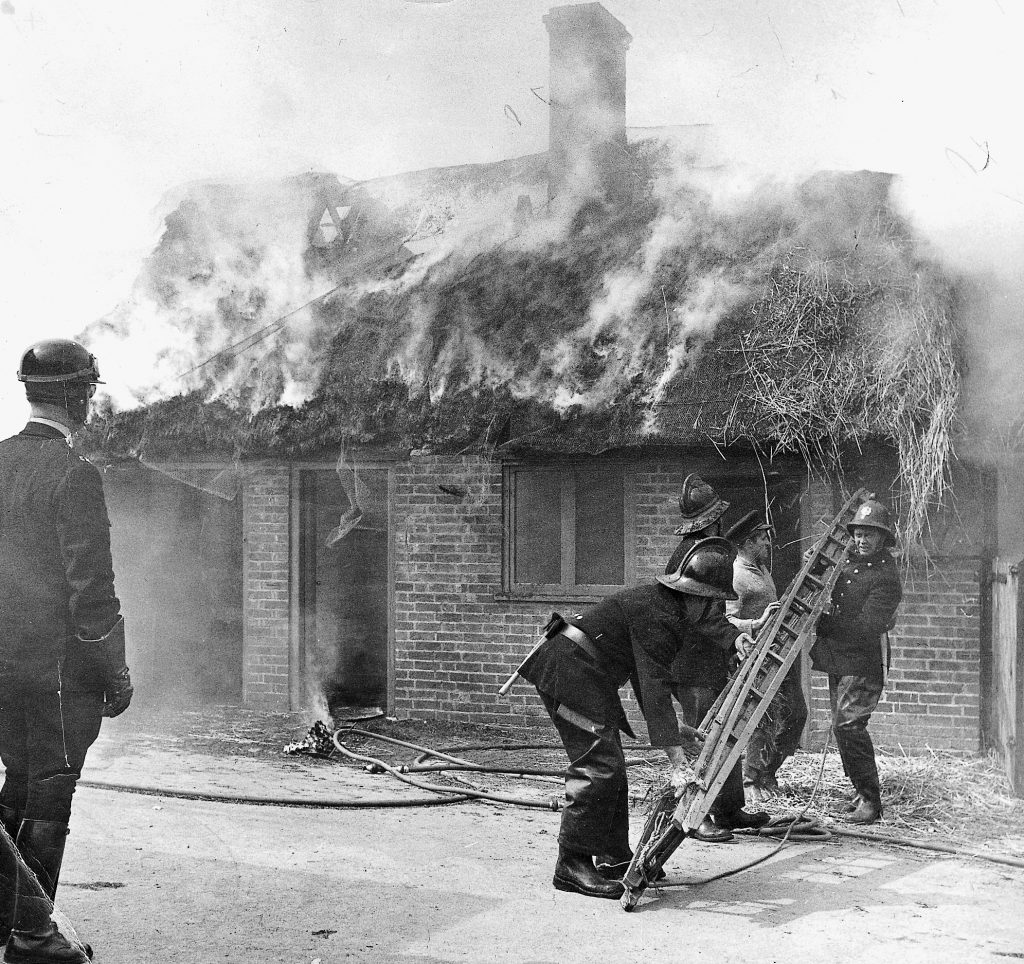
1963
Nineteen calls were recorded this year, with three reliefs back to two of the fires. There were five chimney fires, one tree fire, six house fires, and seven fires on farms in grain dryers, hen pens, and barns full of hay or straw.
At a hay/grass drying plant at Stourton Farm, Whichford Rd, Stourton, the crew were called out on 12 December at 04.30, attending until 12.00, then again on relief from 14.00 until 19.00, and back at 22.00 until 04.30. This fire was in a building on two floors, 150ft by 100ft, containing a drying unit and about 400 tons of bagged grass meal and a large quantity of dried grass. Three jets and three hose reels from the village hydrants were used. All of the dried grass was removed from the building and most of the firemen were covered in a green dust throughout the day.
On 24 December, Christmas Eve, some of the firemen were in Tysoe village pub, the Peacock Inn. One of the locals left the building at 23.10 only to return to the bar to tell the landlord that the thatched roof of the pub was on fire. Before the siren or bells sounded, the pump was out of the station about 100 yards away and a jet was out on to the roof. Four jets and hose reels were used from the village hydrants with two sets of breathing apparatus. These breathing apparatus sets (B.A.s) were from the Stratford upon Avon pump. (Tysoe did not have any B.A. sets until 1972).
Units from Shipston on Stour, Kineton, Stratford upon Avon, Leamington Spa and Southam helped the Tysoe crew at this fire, and the living quarters, garages and stores were all gutted. Throughout most of Christmas Day the crew was on relief duty at the Peacock Inn. This was one of the coldest winters since 1947, and after the fire had eventually been extinguished the extension ladders could not be separated until ice had been removed with hammers. One fireman took off his tunic, which stood up unaided – frozen stiff!
The fire was believed to have been started by a paraffin heater put on the landlord’s car in the garage to keep the vehicle from freezing up.
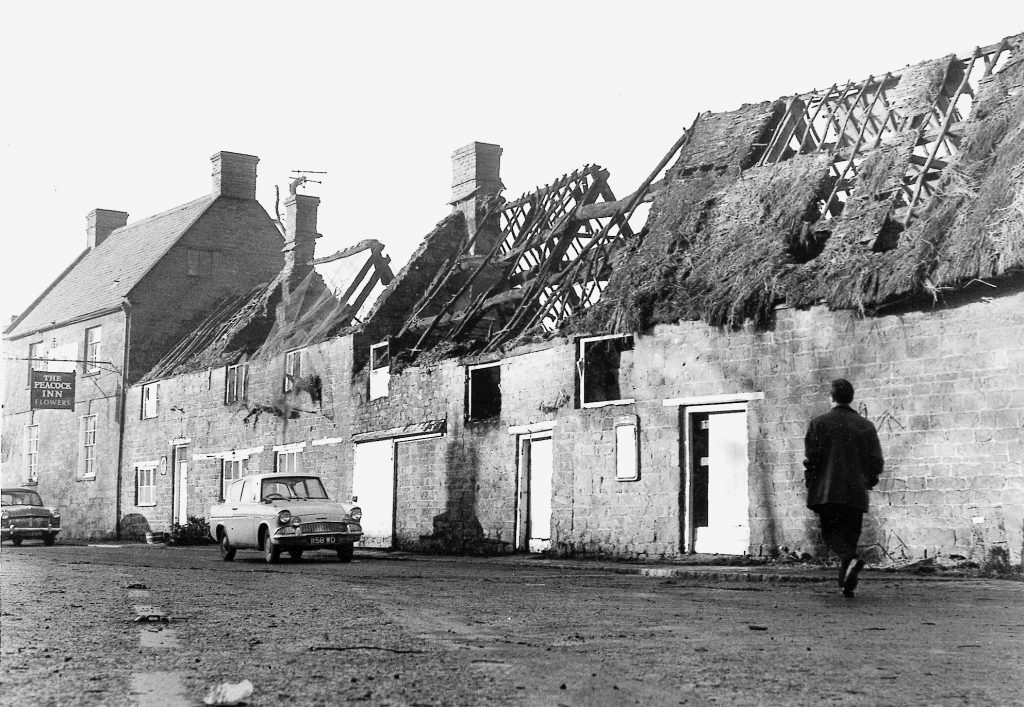
From the beginning of the 1960s until the mid 1970s some members of the crew, together with men from other stations in Warwickshire, would go to the British Grand Prix at Silverstone to act as fire marshals, enjoying a day in the pits or on the inside of one of the bends on the track. The drivers were clearly always pleased to see them.
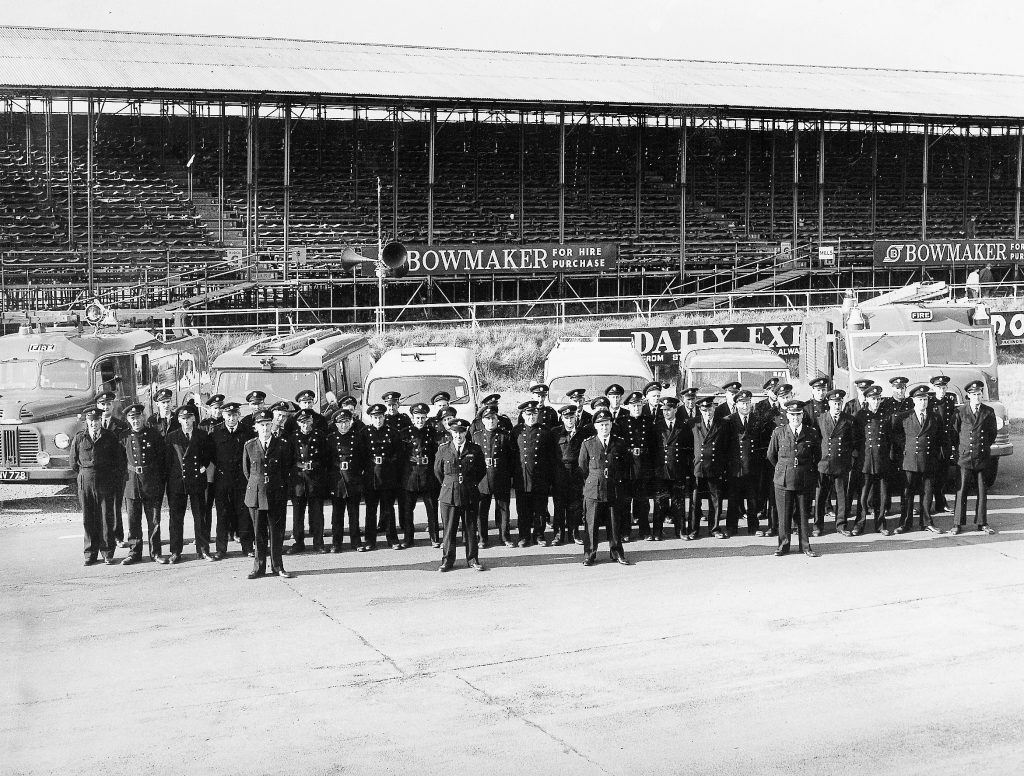
1964
Recorded calls during the year again totalled nineteen, including seven farm fires, six chimney fires, three house fires, one tree fire and two false alarms on automatic fire alarms.
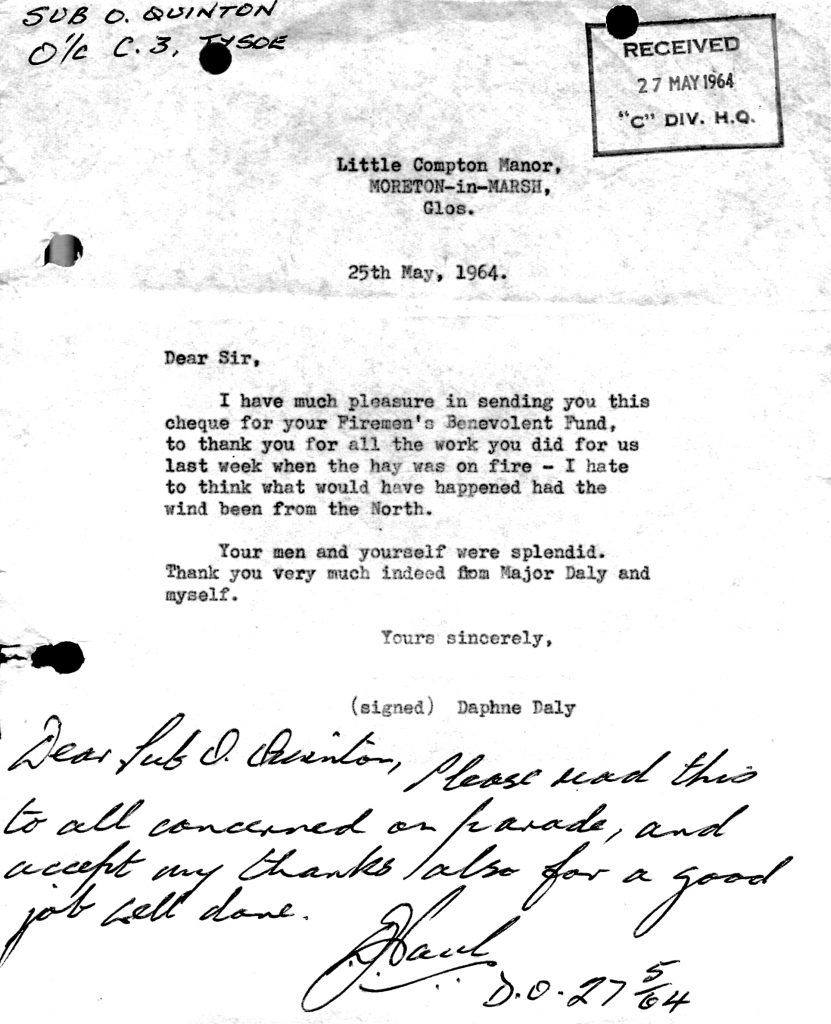
Three of the farm fires were to burning stubble. These fires can cover a large area, the fire often moving faster than a man can run, and they are normally put out by manpower with beaters and hose reels. If the farmer has a tractor with a plough, he can plough around the outside of the burning area and cultivate a strip, which may isolate the fire and pre vent it spreading further.
After stubble fires were extinguished, the men would often be exhausted, which provided an excellent excuse for them, after returning to the Station and cleaning down the equipment, to visit the local pub to replenish some of the lost liquid!
In the Spring the Station number was changed from 27 to Charlie 3, as the Brigade was re-structured.
1965
Eighteen calls were logged, with one vehicle fire, one tree fire, two false alarms, ten house fires and four farm fires, two of which were in Dutch barns.
One of the house fires was to a thatched outbuilding alongside the thatched cottages, which are now opposite the gates to the playing fields in Tysoe.
At this time Leading Fireman B Caswell, a full time fireman who lived in Lower Tysoe, was providing Station cover in his off duty time.
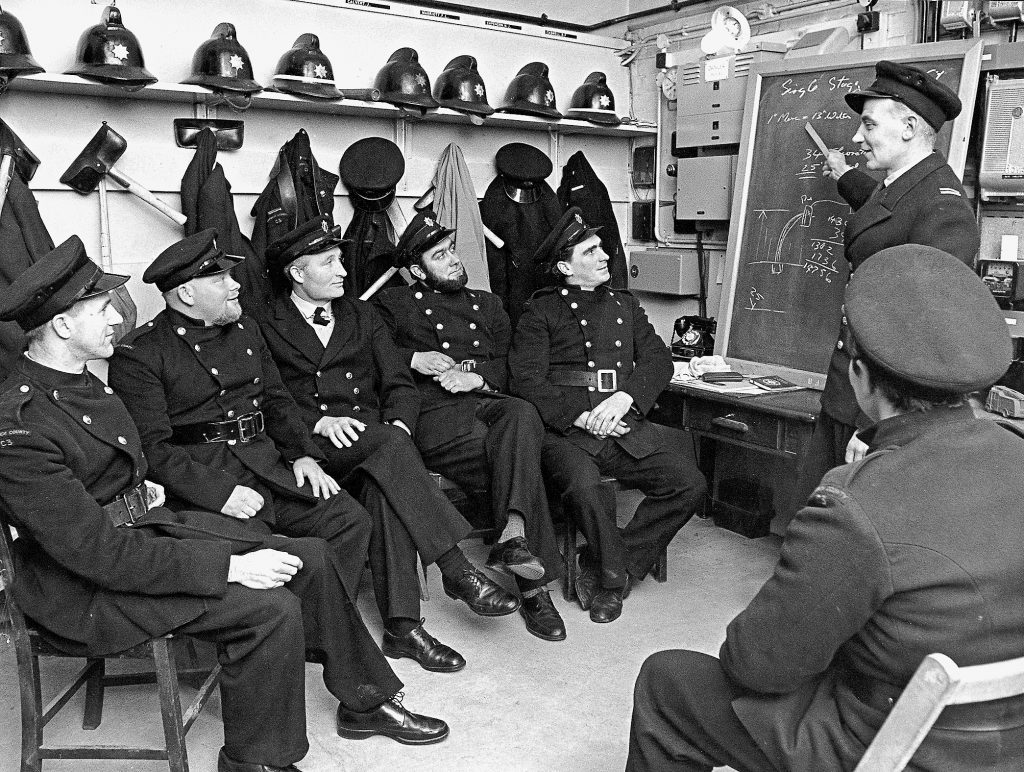
On 1 January the Rev F Marriott, the village vicar, joined the crew as a fireman on the Station. He was excused from fire calls only on a Sunday, but during action at some of the hot farm fires the sight of his “dog collar” when fire tunics were removed certainly tended to restrict the language of the other men, in particular firemen from other stations. Rev Marriott was later to become the official chaplain to the County Fire Brigade, and was in fact the first brigade chaplain in the U.K. Frank Marriott served until 1970.
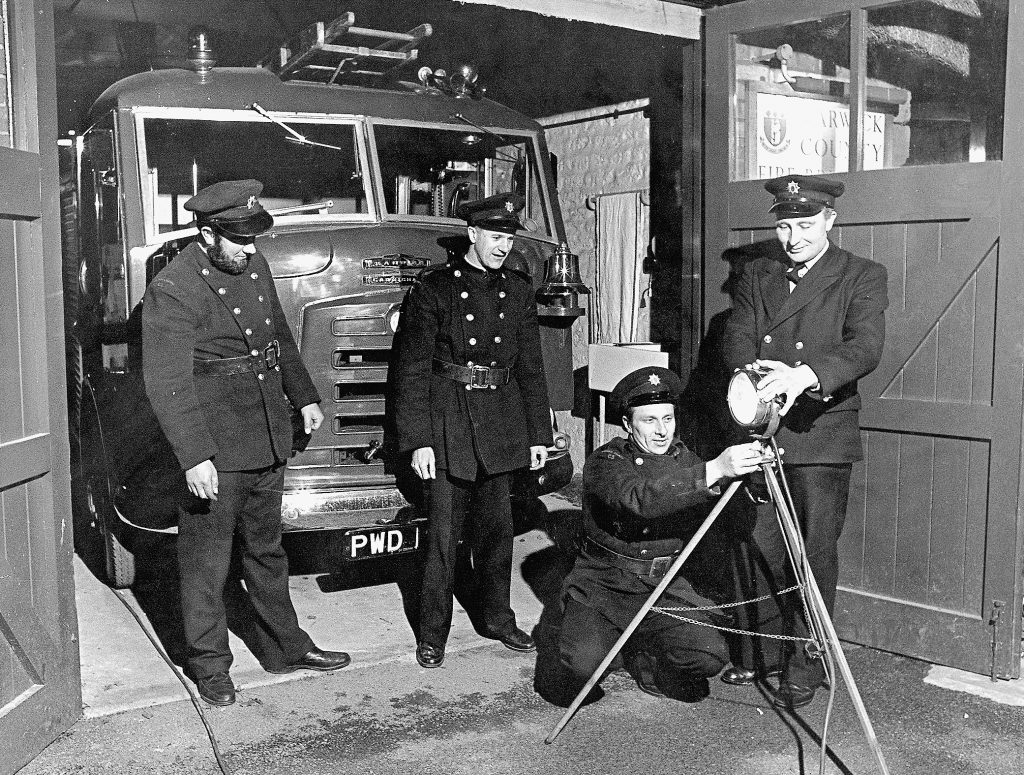
1966
Twenty-two calls were recorded, which comprised one tree on fire, one lorry full of resin on fire on the Shipston to Stratford upon Avon road, one false alarm, one R.T.A. (Road Traffic Accident) on Sunrising Hill, four house fires, six farm fires, and eight chimney Fires.
1967
Another busy year, with twenty-one calls booked.
There was one false alarm, two special service calls to assist with problems due to flooding at Lower Tysoe, five chimney fires, five house fires and eight farm fires, four of which were barn fires.
Fireman E Townsend was promoted to Leading Fireman.
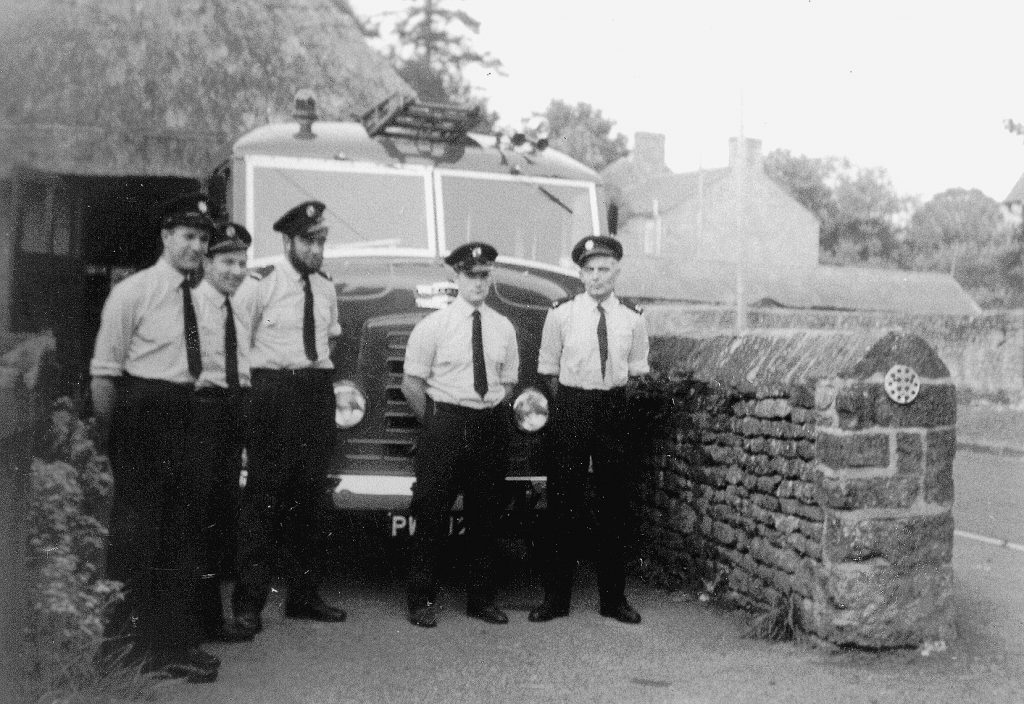
The Station building was now owned by Mrs Gardner, who paid the buildings insurance to General Accident, the premium being £2-12-6d per year and the sum insured £500-0-0d.
At the Fire Brigade Committee Meeting on 18 May at Shire Hall, Warwick, it was recommended that the Council purchase an area of 1,708 square yards from Tysoe Parish Council as a site for a new fire station, since the lease on the existing site was due to expire in 1970.
1968
Local flooding ensured that the crews were kept busy during the year, no fewer than forty-four calls being recorded. These included one tree on fire, three false alarms, seven farm and barn fires, twelve chimney fires, thirteen fires in houses and buildings, including a large fire at Norton School, Kineton, and eight calls to floods at Oxhill, Barcheston, Brailes, Sutton-under-Brailes, Long Compton, Little Kineton, Newbold on Stour and Stratford upon Avon.
Abandoned vehicles were removed at Barcheston and Brailes.
There was extensive flooding in Tysoe and Fire Pumps were called to the village from other stations, as the village crew was already out on emergency calls.
1969
The firemen no longer wore the fireman’s axe and pouch as part of the uniform. Instead these were stowed in a locker on the Pump.
There were twenty-nine calls during the year, with one lorry fire, four false alarms, one tree fire, four chimney fires, seven farm fires and twelve fires in houses and buildings.
Three of the building fire visits were to the Approved Norton School at Little Kineton. On 17 April 1969, the crew was using four Pumps and a hydraulic platform to put out one of the school fires. At this time the hydraulic platform was new to the crew, who at first were not impressed since most of them were drenched to the skin by the monitor jet from the platform.
The other two fires at the school were on 6 and 8 November. Four jets were used on the first call and hose-reels on the second.
In August the crew attended the final Air Show held at R.A.F. Gaydon, after many years of duty at these shows.
The siren was moved during the year from its position on the end of the barn into the garden at the rear of the Station, where it was located on two poles. This was deemed necessary, because the sudden “jerk effect” each time it burst into life was causing the stone gable end of the barn to move!
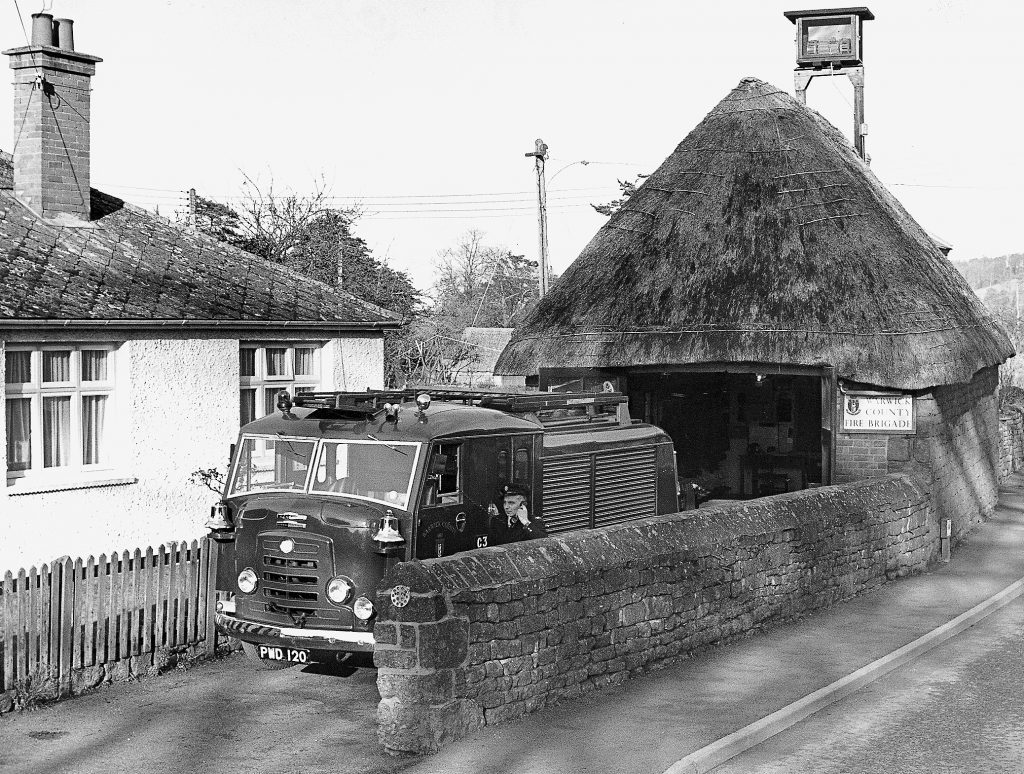
Sub Officer Quinton was presented with the 20 year long service and good conduct medal this year, almost two years late.
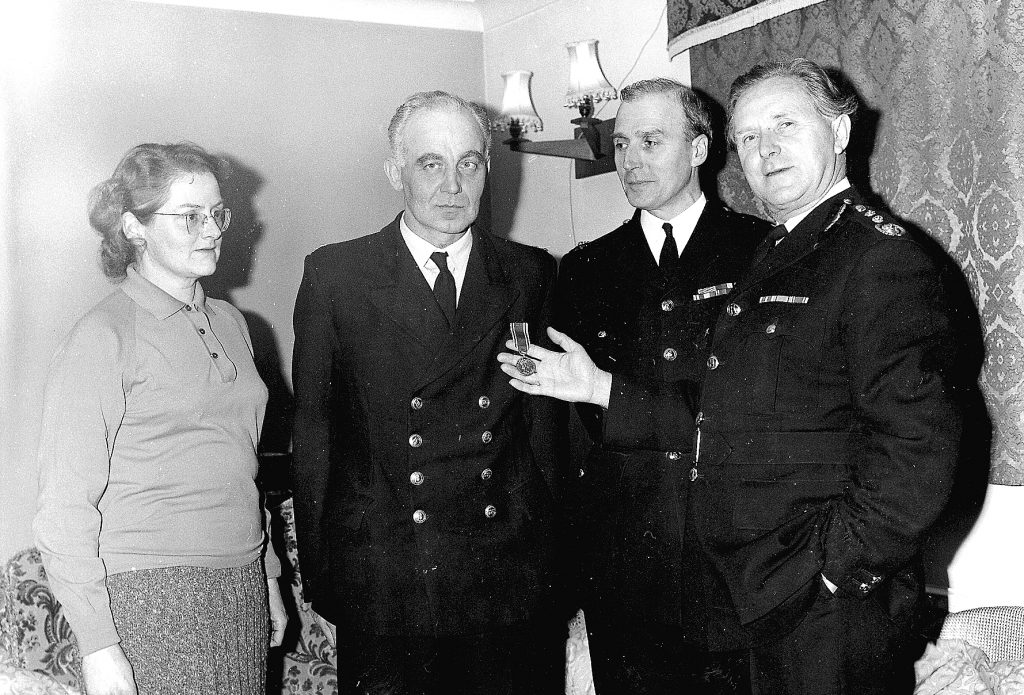
Leading Fireman B. Caswell was promoted at Leamington to Sub Officer.
At the end of the year the station call number was changed from Charlie 3 to Alfa 7.
1970
The Karrier Carmichael PWD 120 was replaced by another Karrier Pump, also of a special design with the ladder let into the roof of the cab, the bells on the front of the engine and the twin horns located on each side of the ladder. The new Pump was registered 5178 AC.
Twenty-nine calls were reported this year, five chimney fires, one car fire, one R.T.A. with fire on Sunrising Hill, eight false alarms, six house and building fires, and eight farm fires, two of which were in Dutch barns. The barn fire at Wroxton St Mary needed a water relay comprising 87 lengths of hose, most of which was from an Oxfordshire Fire Service hose-laying lorry.
1971
During the year there were thirty-seven calls. These involved eight chimney fires, one false alarm, two lorry fires, one of which was a tanker leaking ammonia (in the continued absence of B.A. sets, this was a tricky operation), thirteen house and building fires and thirteen farm fires, seven of which were in Dutch barns.
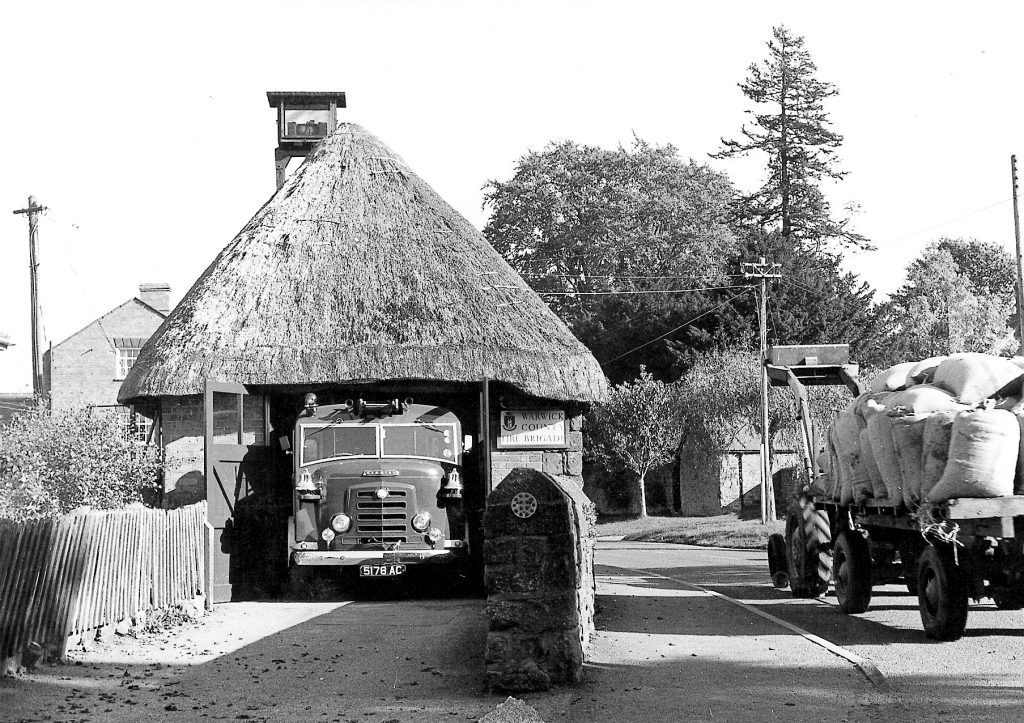
One fire during the year, and certainly the one which produced the most smoke, was at the Industrial Tip at the Ironstone Works at Wroxton St Mary. Tar extracted from the old Gas Works under demolition in Banbury had been tipped into the old quarry and had been set alight. A great deal of foam was used with jets.
The old Wesleyan chapel in Tysoe was also set alight whilst being demolished, one jet and a hose-reel being used on this occasion.
Fireman J Evans was promoted to Leading Fireman during the year.
1972
There were forty-one calls, including one R.T.A., one car fire, one lorry fire, two false alarms, eleven chimney fires, twelve farm fires, including six Dutch barns, twelve houses and buildings on fire, and one special service call to a cow which was firmly stuck in a septic tank at Leasowes Farm on the Stratford upon Avon to Banbury road.
Pump outside Station. From the left, Sub Officer J Quinton, Fireman A Lomas, Fireman K Wyles, Fireman D Paxton, Fireman P Billing, Leading Fireman E Townsend, Leading Fireman J Evans.
The cow was removed by demolishing the end of the brick tank and, on the advice of the local vet, fixing a line around the cow’s neck with the knot under its chin and the other end of the line tied to the back of a tractor tow bar. Careful pulling by the tractor then eased the animal out (it seems that a cow’s neck is the strongest part) with no more than a stiff neck. At least one crew member was not allowed in the cab after his septic tank activities.
The lorry fire was of particular interest in that it was a fully loaded refuse lorry which was actually driven to the Station from the Main Road in Lower Tysoe with a fire in the back (probably the only time a fire was brought to the Station!) The side of the lorry carried a large advertisement encouraging people to save on rates by burning their Rubbish…
The main building fire call was to Shipston on Stour High School, where five jets were used, and B.A. sets were used for the first time by a Tysoe crew at a serious fire.
Fireman A Lomas was promoted to Leading Fireman.
In April Leading Fireman Lomas and Fireman Wyles were the first to attend a B.A. Course. Fireman Wyles became the first B.A. wearer on the Station.
The B.A. sets were stowed in a side locker on the vehicle, since there was no room for them in the cab. The advent of breathing apparatus meant that for the first time there would be no more “eating of smoke” at fires.
Fireman K Oliver joined the Brigade on 22 November 1971. He was the last recruit appointed during the days at the old Thatched Station.
The final fire call from the Thatched Station was on 31 October 1972 at 8.21 am, which involved a trip to William and Woollit at Station Rd, Shipston on Stour. The crew on that call comprised Sub Officer Quinton, Leading Fireman Lomas, Fireman Wyles and Fireman Oliver.
There would be no more racing at speed to the Station in the winter only to discover that the big brass padlock on the doors was frozen and couldn’t be opened until someone found a box of matches and lit one to thaw it out.
Pump under the beams in the Old Station, before the move. From the left, Leading Fireman E Townsend and Fireman K Wyles.
